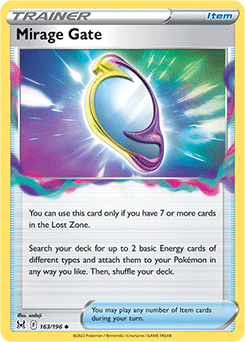Double Top 8 with Broken Gate
Hello everyone, today I am writing about Mirage Gate Toolbox. The Lost Zone engine has been played in several different ways since its release a short time ago. Following the release of Silver Tempest, I played a Lost Zone toolbox deck myself to get Top 4 at the Latin America International Championships in Brazil, followed by Top 8 at Toronto Regionals just a week later. The group of players that played the deck with me also saw strong finishes at these events. This deck was such a strong play primarily due to its favorable matchups against Lugia VSTAR and Mew VMAX, which were the two most popular decks at these events. Going forward, it remains a contender in Tier One, or Tier Two at worst.

The cards that comprise the deck’s consistency engine integrate so well with each other. Comfey and Radiant Greninja are the backbone of the consistency engine. All of the search cards can find them, which makes them all into draw cards. All of the Energy cards serve as fuel for Greninja, making them into draw cards, too. Switching cards allow for extra uses of Comfey, which lets you draw more cards. PokéStop can find switching or search cards, which end up drawing cards. Since all of these different types of cards serve as consistency boosters in addition to their normal functions, the deck becomes quite dangerous. It’s deceptively consistent, and you can get to the bottom of the deck relatively quickly by drawing so many cards.
To take advantage of such a ridiculous engine, the deck employs three insanely high-power cards: Kyogre, Sableye, and Mirage Gate. Past that, you can tech for a variety of different situations or matchups. Mirage Gate and Sableye have some form of synergy with nearly every available attacker in the format. These aspects give the deck power and versatility in addition to its consistency.
However, the deck has a high skill ceiling. The deck forces dozens of tough decisions each game, and makes you meticulously plan several turns ahead, as well as manage your resources perfectly. Although this puts a lot of pressure on you, it also offers an enormous upside. If you play the deck perfectly, you’ll be able to run circles around most opponents, and will almost never lose in matchups that you are prepared for. This is enforced by the fact that it is a single-Prize deck, which naturally makes games go longer. This forces more decisions and resource management from both players, and also gives you lots of comeback potential in case things don’t start smoothly.
I am a fan of the sense of agency this deck gives the player, as opposed to a deck like Lugia VSTAR. Lugia is a powerhouse of a deck, but offers few decisions each turn, and often bricks. Many turns with Lugia could be run by a simulator, mindlessly playing out the cards in your hand. With how fast games have gone in recent formats, I’ve often been left with the feeling that skill is irrelevant in determining the outcomes of games. You have to make decisions in every game of Pokemon, but I felt that most decisions didn’t really matter all that much. Either you or your opponent drew better, and the game was over in three or four turns. Mirage Gate Toolbox feels like the complete opposite.
In short, the deck has ridiculous consistency thanks to its unique and integrated engine, crazy power due to its specific trump cards, versatility and unpredictability because of Mirage Gate, a high skill ceiling because it forces so many important decisions that directly reward your planning and skill, and favorable matchups against two of the format’s most dominant decks. It’s no surprise that my testing group has seen such astounding results with the deck.
This concludes the public portion of this article.
If you'd like to continue reading, consider purchasing a PokeBeach premium membership! If you're not completely satisfied with your membership, you can request a full refund within 30 days.
Each week we post high-quality content from some of the game's top players. Our article program isn't a corporate operation, advertising front, or for-profit business. We set our prices so that we can pay the game's top players to write the best content for our subscribers. Each article topic is carefully selected, goes through multiple drafts, and is touched up by our editors. We take great pride in our program!

